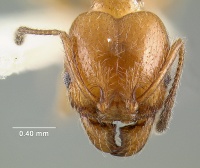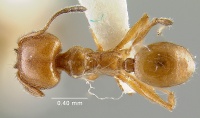Pheidole peregrina
| Pheidole peregrina | |
|---|---|

| |
| Scientific classification | |
| Kingdom: | Animalia |
| Phylum: | Arthropoda |
| Class: | Insecta |
| Order: | Hymenoptera |
| Family: | Formicidae |
| Subfamily: | Myrmicinae |
| Tribe: | Attini |
| Genus: | Pheidole |
| Species: | P. peregrina |
| Binomial name | |
| Pheidole peregrina Wheeler, W.M., 1916 | |
| Synonyms | |
| |
On the type series, by Hermann von Ihering, as quoted by W. M. Wheeler (1916: 180–181): “One morning, while [Mr. Gaste, a local naturalist] was on the island of San Sebastian, he found a tree trunk that had floated to the shore during the night and was filled with a living ant-colony belonging to a species of Pheidole [peregrina Wheeler] unknown to me. San Sebastian is situated some kilometers off the coast of the mainland. Of course, we cannot say how long this log had been floating in the water before it reached the island.” It may be that peregrina, like the anatomically similar and widespread vafra, is a specialist in marginal habitats. The types of the synonymous Pheidole impariceps var. fusciclava were collected on another island in the same area, Ilha dos Alcatrazes. (Wilson 2003)
Identification
See the description in the nomenclature section.
Keys including this Species
Distribution
Known from several localities in São Paulo state. (Wilson 2003)
Latitudinal Distribution Pattern
Latitudinal Range: -21.9° to -24°.
| North Temperate |
North Subtropical |
Tropical | South Subtropical |
South Temperate |
- Source: AntMaps
Distribution based on Regional Taxon Lists
Neotropical Region: Brazil (type locality).
Distribution based on AntMaps
Distribution based on AntWeb specimens
Check data from AntWeb
Countries Occupied
| Number of countries occupied by this species based on AntWiki Regional Taxon Lists. In general, fewer countries occupied indicates a narrower range, while more countries indicates a more widespread species. |

|
Estimated Abundance
| Relative abundance based on number of AntMaps records per species (this species within the purple bar). Fewer records (to the left) indicates a less abundant/encountered species while more records (to the right) indicates more abundant/encountered species. |

|
Biology
Castes
Nomenclature
The following information is derived from Barry Bolton's Online Catalogue of the Ants of the World.
- peregrina. Pheidole peregrina Wheeler, W.M. 1916l: 181 (s.w.q.) BRAZIL. Senior synonym of fusciclava, impariceps: Wilson, 2003: 214.
- fusciclava. Pheidole impariceps var. fusciclava Santschi, 1923d: 48 (s.w.m.) BRAZIL. Junior synonym of peregrina: Wilson, 2003: 214.
- impariceps. Pheidole impariceps Santschi, 1923d: 47 (s.w.) BRAZIL. Junior synonym of peregrina: Wilson, 2003: 214.
Unless otherwise noted the text for the remainder of this section is reported from the publication that includes the original description.
Description
From Wilson (2003): A small, yellow member of the diligens group whose major has posterior two-thirds of head capsule smooth and shiny, rugoreticulum present as a small patch just mesad to the eye, moderately abundant pilosity, and short equilaterally triangular propodeal spine in side view.
Similar to Pheidole blumenauensis, Pheidole laevifrons, Pheidole insipida, Pheidole rochai and Pheidole vafra, differing in many details of body form, sculpturing, and pilosity, as figured.
See also the somewhat less similar Pheidole lemur, Pheidole pubiventris, Pheidole seeldrayersi, Pheidole spilota, Pheidole variegata (= Pheidole pubiventris), Pheidole venatrix and Pheidole zelata.
MEASUREMENTS (mm) Lectotype major: HW 1.00, HL 1.06, SL 0.74, EL 0.14, PW 0.56. Paralectotype minor: HW 0.54, HL 0.64, SL 0.76, EL 0.14, PW 0.36.
COLOR Major: concolorous dark yellow.
Minor: head light brownish yellow, rest of head and appendages clear dark yellow.
Figure. Upper: lectotype, major. Lower: paralectotype, minor. Scale bars = 1 mm.
Type Material
BRAZIL: Isla São Sebastião, São Paulo. Museum of Comparative Zoology - as reported in Wilson (2003)
Etymology
L peregrina, traveling, foreign. Referring to discovery of the type colony on a floating log. (Wilson 2003)
References
- Wheeler, W. M. 1916p. Ants carried in a floating log from the Brazilian mainland to San Sebastian Island. Psyche (Camb.) 23: 180-183 (page 181, soldier, worker, queen described)
- Wilson, E. O. 2003. Pheidole in the New World: A dominant, hyperdiverse ant genus. Harvard University Press, Cambridge, MA.
References based on Global Ant Biodiversity Informatics
- Favretto M. A., E. Bortolon dos Santos, and C. J. Geuster. 2013. Entomofauna from West of Santa Catarina State, South of Brazil. EntomoBrasilis 6 (1): 42-63.
- Kempf, W.W. 1972. Catalago abreviado das formigas da regiao Neotropical (Hym. Formicidae) Studia Entomologica 15(1-4).
- Rosa da Silva R. 1999. Formigas (Hymenoptera: Formicidae) do oeste de Santa Catarina: historico das coletas e lista atualizada das especies do Estado de Santa Catarina. Biotemas 12(2): 75-100.
- Santschi F. 1923. Pheidole et quelques autres fourmis néotropiques. Annales de la Société Entomologique de Belgique 63: 45-69.



